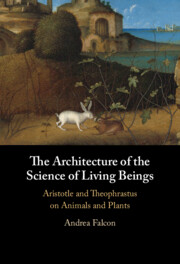59 results
Chapter 16 - Plants in the Literatures of Southern Africa
- from Part III - Global Regions
-
-
- Book:
- The Cambridge Handbook of Literature and Plants
- Published online:
- 06 February 2025
- Print publication:
- 13 February 2025, pp 304-324
-
- Chapter
- Export citation
Chapter 6 - Portraits of Plants
- from Part I - Historical Periods
-
-
- Book:
- The Cambridge Handbook of Literature and Plants
- Published online:
- 06 February 2025
- Print publication:
- 13 February 2025, pp 109-128
-
- Chapter
- Export citation
Chapter 8 - Shakespeare’s Plants Then and Now
- from Part II - Anglophone Literary Forms
-
-
- Book:
- The Cambridge Handbook of Literature and Plants
- Published online:
- 06 February 2025
- Print publication:
- 13 February 2025, pp 149-165
-
- Chapter
- Export citation
Chapter 2 - Inspective Fruits
- from Part I - Historical Periods
-
-
- Book:
- The Cambridge Handbook of Literature and Plants
- Published online:
- 06 February 2025
- Print publication:
- 13 February 2025, pp 23-50
-
- Chapter
- Export citation

Botanical Culture and Popular Belief in Shakespeare's England
-
- Published online:
- 02 January 2025
- Print publication:
- 09 January 2025
9 - California Conflicts
-
- Book:
- Ethics and the Environment
- Published online:
- 29 November 2024
- Print publication:
- 28 November 2024, pp 180-197
-
- Chapter
- Export citation
7 - The Value of Nature
-
- Book:
- Ethics and the Environment
- Published online:
- 29 November 2024
- Print publication:
- 28 November 2024, pp 131-153
-
- Chapter
- Export citation
6 - John Clare’s Plants
- from Part II - Clare the Naturalist
-
-
- Book:
- The Cambridge Companion to John Clare
- Published online:
- 14 November 2024
- Print publication:
- 21 November 2024, pp 91-105
-
- Chapter
- Export citation
Introduction
-
- Book:
- The Architecture of the Science of Living Beings
- Published online:
- 30 May 2024
- Print publication:
- 06 June 2024, pp 1-14
-
- Chapter
-
- You have access
- Open access
- HTML
- Export citation
Chapter 5 - Theophrastus on the Generation of Plants (Causes of Plants I)
-
- Book:
- The Architecture of the Science of Living Beings
- Published online:
- 30 May 2024
- Print publication:
- 06 June 2024, pp 152-186
-
- Chapter
-
- You have access
- Open access
- HTML
- Export citation
Chapter 6 - The Invention of Biology?
-
- Book:
- The Architecture of the Science of Living Beings
- Published online:
- 30 May 2024
- Print publication:
- 06 June 2024, pp 187-208
-
- Chapter
-
- You have access
- Open access
- HTML
- Export citation
Chapter 1 - Aristotle’s De anima and the Study of Perishable Living Beings
-
- Book:
- The Architecture of the Science of Living Beings
- Published online:
- 30 May 2024
- Print publication:
- 06 June 2024, pp 15-45
-
- Chapter
-
- You have access
- Open access
- HTML
- Export citation
Chapter 2 - Aristotle’s Parva naturalia and the Study of Animals and Everything That Has Life
-
- Book:
- The Architecture of the Science of Living Beings
- Published online:
- 30 May 2024
- Print publication:
- 06 June 2024, pp 46-76
-
- Chapter
-
- You have access
- Open access
- HTML
- Export citation
Chapter 4 - The Transition from the Study of Animals to the Study of Plants (History of Plants I)
-
- Book:
- The Architecture of the Science of Living Beings
- Published online:
- 30 May 2024
- Print publication:
- 06 June 2024, pp 121-151
-
- Chapter
-
- You have access
- Open access
- HTML
- Export citation

The Architecture of the Science of Living Beings
- Aristotle and Theophrastus on Animals and Plants
-
- Published online:
- 30 May 2024
- Print publication:
- 06 June 2024
-
- Book
-
- You have access
- Open access
- Export citation
Flow charts as a method to transfer self-sealing from plant models into programmable materials and related challenges
-
- Journal:
- Programmable Materials / Volume 1 / 2023
- Published online by Cambridge University Press:
- 18 December 2023, e12
-
- Article
-
- You have access
- Open access
- HTML
- Export citation
Chapter 6 - ‘Already Verified’
- from Part I - Transmission of Pharmacological Knowledge
-
-
- Book:
- Drugs in the Medieval Mediterranean
- Published online:
- 19 October 2023
- Print publication:
- 02 November 2023, pp 204-242
-
- Chapter
- Export citation
Chapter 3 - Appreciating Nature Aesthetically in The World as Will and Representation: Between Kant and Hegel
-
-
- Book:
- Schopenhauer's 'The World as Will and Representation'
- Published online:
- 08 December 2022
- Print publication:
- 22 December 2022, pp 49-73
-
- Chapter
- Export citation
20 - Diet
- from Part II - Applications: What Can We Do about the Opportunity of Aging?
-
- Book:
- Unaging
- Published online:
- 15 September 2022
- Print publication:
- 20 October 2022, pp 225-245
-
- Chapter
- Export citation
7 - Elite Cultures in Seventeenth-Century South Asia
-
- Book:
- India before Europe
- Published online:
- 15 September 2022
- Print publication:
- 08 September 2022, pp 231-287
-
- Chapter
- Export citation

